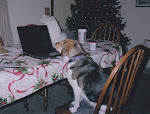I was reminded Sunday of how important it is to teach your children safety around dogs. I have written on this subject before, but feel it is so important that it is worth repeating.
We have all seen the wonderful old TV shows, a little boy running with his pet dog, so happy and so well behaved. Think Timmy and Lassie. Lassie saves the boy from yet another disaster and receives a big neck squeezing hug in return. It all looks great on TV but in real life Timmy might just have gotten his face bit if he tries that with a dog who sees it as a threat.
I have a young grandson who loves dogs, however he has not been taught that running up to a dog can be a sign of aggression or attack. In a dog's world this approach means defensive posture and protect ones self. I watched Sunday as an old man was walking his little dog and my grandson ran straight at them. The poor dog lunged at the boy, pulling on the leash, barking and growling a warning to stay back. The old man held the dog back, but he would not have been able to if it had been a big dog. My grandson would have run arms open into the face of a dog who felt threatened. It could have turned into a disaster. He could have been bitten, scarred for life, and the poor dog would have probably had to be put down for "attacking a child"
People please remember biting is a dogs last defense. A healthy dog will usually not attack without warning or reason. Know dog body language, it is your first tell tale sign of how a dog is feeling. LOOK; the posture, the tail, the ears, and the lips. LISTEN; breathing, growling, the bark. A happy bark sounds much different then a scared bark and it certainly sounds different from a don't come any closer bark. Here are some very good drawings of what might be going on with a dog. You have most likely seen a dog do some of these things, a playful bow or relaxed is good. A dog in the dominant or defensive posture means trouble. Do not approach!
Teach your children from when they are small that dogs do not like screaming, someone running up to them too fast, and they do not like to be hugged around the neck. Explain to your child that it is like a big person holding them very tight and not letting go. They, your child, would need to kick and hit, but a dog bites instead. It is their way of protecting themselves.
If taught from a young age, children will grow to respect dogs as living creatures. Hopefully there will be fewer children bitten, less animal abuse, fewer dogs being surrendered to shelters, and no dogs being put down because they defended themselves.
Teach your children respect for dogs and teach your dogs good behavior with children. It's a win win for everyone.
Tuesday, March 9, 2010
Kids and Dogs
Labels:
children,
dog barking,
dog bites,
dog posture,
dogs,
dominance,
growling,
play bow
Subscribe to:
Post Comments (Atom)






No comments:
Post a Comment